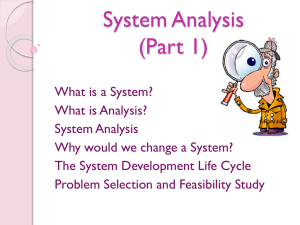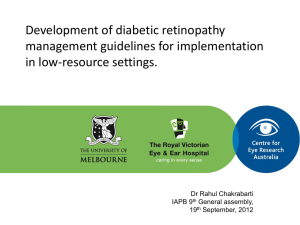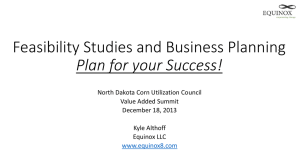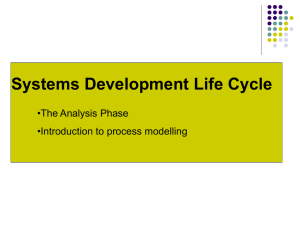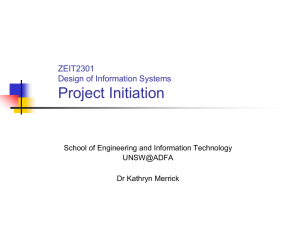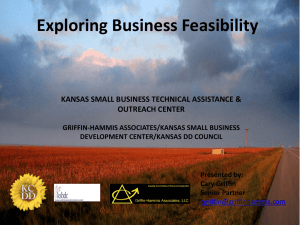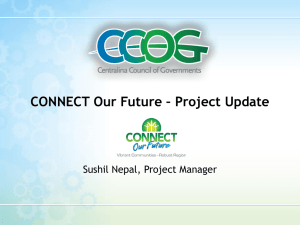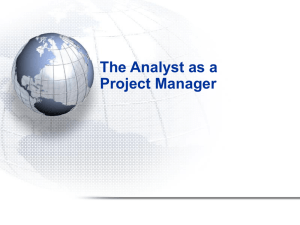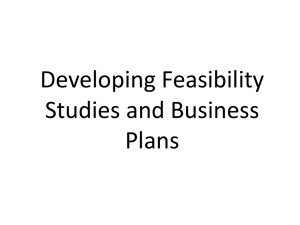Project Management
advertisement
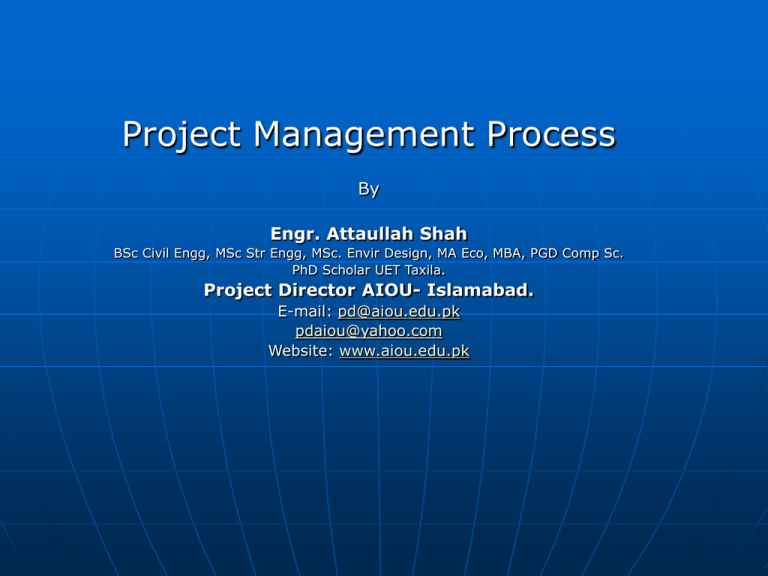
Project Management Process By Engr. Attaullah Shah BSc Civil Engg, MSc Str Engg, MSc. Envir Design, MA Eco, MBA, PGD Comp Sc. PhD Scholar UET Taxila. Project Director AIOU- Islamabad. E-mail: pd@aiou.edu.pk pdaiou@yahoo.com Website: www.aiou.edu.pk What is a Project? An endeavor to create a Unique Product or Service. A unique one time effort bound by cost, time and resources/technical performance ( CST) and has defined objectives to satisfy the customer needs. Project is an undertaking having definite objectives, and specific beginning and ending points, limited budgets, defined scope. Sum of certain activities and tasks required to be performed in a specified period of time with human and non-human resources for specified objectives. ( Is your training a project? ) Project is a one time non-routine opportunity to develop a new product. To satisfy the customer to achieve the organizational objectives. To be completed with in • Allocated budget. • Scheduled Time. • Approved Technical Performance. • Approved and agreed Scope of Work. • Without any change in the existing culture. Project Life-Cycle Project Planning( Pre-Investment Studies): • Project Opportunity Analysis ( Identification) • Project Selection & Problem analysis. • Project Pre-feasibility studies. • Project Feasibility Studies • Preliminary Design • Cost Estimation. Implementation ( Investment Phase) • • • • • • • • Detailed Design. Pre-qualification of bidders Tendering & Negotiation Construction and developing the facility Test Deployment Operation Commissioning • • • • Up-keeping ( Preventive) Adoptive Maintenance ( Project Integration). Enhancement Decommission Maintenance. What is management? The process of Planning, Organizing, Staffing, controlling and leading. Project management: The art of Directing and coordinating the human and non human Resources throughout the life of project by using modern Management techniques to achieve pre-determined objectives of scope, cost, time, quality and participants satisfaction. ( Project Management Institute America) - Project management includes: Project Appraisal ( Before Commencement of Project PC-I, PC-II). - Project monitoring. ( During Execution of the Projects PC-III) - Project Evaluation ( After Completion of the projects. PC-IV,PC-V) Different Forms used by Planning Commission of Pakistan. PC-I Forms - Production Sectors - Infrastructure Sectors - Social Sectors. PC-II Form Survey and Feasibility Studies. PC-III Form PC-III (A) form for Physical Targets based on PSDP Allocations & Activity Chart. PC-III(B) Monthly Progress Reporting. PC-IV Form Project Completion Report. PC-V Form Annual Performance Report After Completion of Project Assessing Project Feasibility You need to calculate Nine categories of feasibility: • Economic • Financial • Operational & Technical • Schedule • Legal and contractual • Political • Marketing • Ethical • Environmental Project Appraisal. Technical Analysis The analysis for determining the technical viability of the development project is based on the technical data and information given in the PC-I form as well as the earlier experience of carrying out similar projects. Institutional/Organizational/Managerial Analysis A whole range of issues in project preparation revolves around the overlapping institutional, organizational and managerial aspects of the project. Social Analysis Social analysis is undertaken to examine the aspects like employment opportunities and income distribution. Commercial Analysis The commercial aspects of a project include the arrangements for marketing the output produced by the project and the arrangement for the supply of inputs needed to build and operate the project Financial Analysis Financial analysis involves assessment of financial impact, judgment of efficient resource use, assessment of incentives, provision of a sound financing plan, coordination of financial contribution and assessment of financial management competence. Assessing Economic Feasibility Determine Tangible Costs Can easily be measured in dollars • Determine Tangible One-Time Costs • Associated with project startup, initiation and development • Includes System Development New hardware and software purchases User training Site preparation Data or system conversion Assessing Economic Feasibility • Time value of money (TVM) Process of comparing present cash outlays to future expected returns Calculate net present value (NPV) • Break even analysis When will project break even (costs=benefits) Assessing Economic Feasibility • Determine Tangible Recurring Costs Associated with on-going use of system Includes: • Application software maintenance • Incremental data storage expense • New software and hardware releases • Consumable supplies Determine Intangible Costs Cannot be easily measured in dollars Examples: • Loss of customer goodwill • Loss of employee morale Assessing Economic Feasibility Determine Intangible Benefits Cannot be measured easily Examples • Increased employee morale • Competitive necessity • More timely information • Promotion of organizational learning and understanding Assessing Other Project Feasibility Concerns Remaining are specific intangible costs Operational Feasibility How likely is it that system can be used to meet desired objectives? (e.g., functional illiterate line workers make up 90% of production staff…can proposed system work at our facility?) Technical Feasibility Assessment of development organization’s ability to construct a proposed system Assessing Other Project Feasibility Concerns Schedule Feasibility • Assessment of timeframe and project completion dates with respect to organization constraints for affecting change Legal and Contractual Feasibility • Assessment of legal and contractual ramifications of new system (e.g., does it violate the union contract?) Assessing Other Project Feasibility Concerns Political Feasibility • Assessment of view of key stakeholders in organization toward proposed system (e.g., How will this affect morale? Will we see a worker slowdown in other areas?) Ethical Feasibility • Are there issues that are inconsistent with corporate ethics and goals even if legal (e.g., lots of e-waste?) With above analyses, firm can rank order project and determine if it should be done via prioritization… Product Development Map Project Management Processes Project Management Data Flow Diagram Start Up Project Review lessons learned Establish key success criteria Plan the project Develop the Integrated Management Plan Review risks and opportunities Assemble the project team Launch the project. Project Management Processes Plan Project - Gantt and Network Charts List all activities – The contract is your guide! Activities should have defined deliveries and be a few weeks duration Estimate duration, level of effort and material spend for each activity Connect activities with minimum dependency logic – can start at the end and work back to the start Keep plans simple – e.g. use a hierarchy for more than 30 tasks Rolling plan on long projects – add detail as you go Add resources to chart and level usage by adjusting the start time of non-critical tasks Review and baseline plans and budgets Determine critical path and sit on it! Use a planning tool to ease task of producing and keeping project plans and reports up to date The Project Management Jargon Work Breakdown Structure (WBS) • What is to be done in Work Packages • Work Packages relate to cost collection points Organisational Breakdown Structure (OBS) • Who will do it Earned Value Management (EVM) • Objective reporting of progress and variances to plan Plan Project OBS Eng CONTRAC T Specs SOW ANO ANO ANO QA Ops XNO XNO XNO Team A Team B Who What WBS A Sample Design Manufacture Hardware B Sample Design Software Responsibility Assignment Matrix Logic network How W rit e U R D S t a rt : 2 3 / 1 1 /0 5 I D: F i n ish : 0 6 /1 2 / 0 5 Du r : 1 0 d a y s 3 R e s: A b st ra ct Mod el So lu t io ns W rit e SR D S t a rt : 0 7 / 1 2 /0 5 I D: S t a rt : 2 8 / 1 2 /0 5 I D: F i n ish : 2 7 /1 2 / 0 5 Du r : 1 5 d a y s F i n ish : 2 4 /0 1 / 0 6 Du r : 2 0 d a y s 4 R e s: 5 R e s: Plan Project W rit e C o mpo ne nt D e sign Spe cs C o mpo ne nt D es ig n S t a rt : 2 5 / 0 1 /0 6 I D: S t a rt : 0 1 / 0 2 /0 6 I D: F i n ish : 3 1 /0 1 / 0 6 Du r : 5 d a y s F i n ish : 2 8 /0 2 / 0 6 Du r : 2 0 d a y s 7 R e s: 8 R e s: W rit e A rc hit ec t ure TS S t a rt : 2 5 / 0 1 /0 6 I D: F i n ish : 3 0 /0 1 / 0 6 Du r : 4 d a y s 15 R e s: W rit e IC D S S t a rt : 2 8 / 1 2 /0 5 I D: F i n ish : 0 3 /0 1 / 0 6 Du r : 5 d a y s 6 R e s: W rit e STS S t a rt : 0 7 / 1 2 /0 5 I D: F i n ish : 1 3 /1 2 / 0 5 Du r : 5 d a y s 19 R e s: Project Reports Gantt When ID 1 Task Name 2 Elicit User Requirements 3 Write URD 4 Abstract Model Solutions 5 Write SRD 6 Write ICDS 7 Write Component Design Specs 8 Component Design 9 Design & Bulid Component 10 Write Component TS 11 Perform Component T 12 Write Component TR 13 Integrate Components V1 14 Integrate Componenets v2 15 Write Architecture TS 16 Perform Integration T V1 17 Perform Integration T V2 18 Write ITR 19 Write STS 20 Perform ST 21 Write STR EVM Resource November December January February March April May June July August 07/11 21/11 05/12 19/12 02/01 16/01 30/01 13/02 27/02 13/03 27/03 10/04 24/04 08/05 22/05 05/06 19/06 03/07 17/07 31/07 14/08 28/08 RS W P £k Per cen t I d 1 A Sample Design 20 59 2 Software Design 8 36 3 Code 7 32 4 U Test 5 23 5 Integrate 33 14 6 RF design 25 14 7 Implement 19 5 8 RF Test 11 5 Project Management Processes Monitor and Control Use this process regularly Update plans, actual costs, risks and opportunities, performance metrics Seek feedback from customer Review these internally with the project Review these with senior management Deming Cycle Monitor and Control Update plan, look forward – obtain an estimate to complete for each activity (not percentage completed) ID 1 T ask Name 2 Elicit User Requirements 3 Write URD 4 Abstract Model Solutions 5 Write SRD 6 Write ICDS 7 Write Component Design Specs 8 Component Design 9 Design & Bulid Component 10 Write Component TS 11 Perform Component T 12 Write Component TR 13 Integrate Components V1 14 Integrate Componenets v2 15 Write Architecture TS 16 Perform Integration T V1 17 Perform Integration T V2 18 Write ITR 19 Write ST S 20 Perform ST 21 Write ST R November December January February March April May June July Earned Value Management Costs RS Risk Budget Planned Value PV Actual Cost AC CV SV Earned Value EV T now Time end Schedule Variance (RS) = EV - PV Cost Variance (RS) = EV - AC Estimate To Complete Project Evaluation Flowchart Office/Historical Data Collection Initial Site Visit Primary Field Survey Initial Data Analysis Secondary Field Survey Laboratory Materials Characterization Secondary Data Analysis Structural Capacity Analysis The Elements of a Successful Proposal # 1:The title Choose a title that conveys information about your project. Avoid acronyms that have negative connotations. Make it Brief # 2: The abstract This is the first (and could be the only) part of the proposal that a busy reviewer will see. The abstract should be a map of the rest of the proposal. Write the abstract last to make sure it reflects the final version of the proposal. # 3: Problem statement Provide a clear objective statement of the problem. Describe the factors that have contributed to the problem. Describe what has and has not worked in the past. Indicate what needs to be done (by you) now. # 4: The rationale Never assume the proposal reviewer knows what you know. Convince the reviewer that the problem is IMPORTANT! Persuasive rationales Describe how the project will… Resolve theoretical questions Develop better theoretical models Influence public policy Improve teaching/learning Improve the way people do their jobs in a particular field Improve the way people live #5: Literature review Display your awareness of the problem or need as well as the contributions that have been made by others—some of whom may be reviewers of your proposal! Show you understand the problem! Use the Funding Agencies “Terms” and “Vocabulary” to Describe the Problem. Provide the most recent data and/or information about the problem. Describe the gaps and contradictions that currently exist. Show you know the solution! Describe a solution to improve the situation. Back up your solution with data if possible. Quote or cite well known authorities on the topic. # 6: Project design Goals, Objectives and Activities Should Always Relate to One Another Program elements Goals: Broad Statements of Intent Objectives: Measurable Outcome Statements Activities: Implementation Steps Well written objectives State Who is Responsible State What is to be Accomplished. State When the Objective should be Accomplished State a Criterion for Success Well written activities Focus on How the objective is to be accomplished. Use “Action” words, e.g., recruit, analyze, evaluate, disseminate Research methods State your research questions clearly Choose an appropriate research design Detail all procedures Control for validity and reliability Describe limitations Answer reviewers’ questions before they are asked! # 8: Key personnel Describe the people that will help to make decisions in how the project is carried out. Provide a description of their background, training, and expertise. Highlight everyone’s accomplishments—this is not the time to be modest! # 9: Facilities & resources Describe where the project will be conducted. Describe any special equipment or resources you will have access to. Describe any special capabilities or experiences possessed by your agency to carry out the project. # 10: Budget Ask for the funds that you need to be successful, but do not pad your budget. Be aware that proposal reviewers know how much things cost! If you ask for too little money to do the work you propose, you will appear naïve and inexperienced. # 11: Time lines Sponsored project activities can take longer than anticipated. Do not propose to do too much in any given project period. Develop a time line for the reviewer. #12: Evaluation Describe how you will find out if your project is working. Describe how you will know if you have succeeded when the project is over. Describe how you will adjust your procedures and timelines to deal with real life events. Tell the proposal reviewers who will conduct the evaluation and review the information collected. #13: Dissemination Inform the proposal reviewers of the dissemination strategies that you will use and the audiences that will receive information on your findings. Information about your project can be disseminated via articles in peer reviewed journals and presentations at professional conferences. #14: Continuation funding Sponsored Projects are of limited duration, e.g., 1 to 3 years Plan your next project before the current project ends! #15: Follow through Keep your program officer in mind: send copies of all publications and media coverage related to your project. Network with others: Look for ways to collaborate on future projects. Some Funny Quotes of Project Managers As of tomorrow, employees will only be able to access the building using individual security cards. Pictures will be taken next Wednesday and employees will receive their cards in two weeks. What I need is a list of specific unknown problems we will encounter. E-mail is not to be used to pass on information or data. It should be used only to be used for company business. Turnover is good for the company, as it proves that we are doing a good job in training people. This project is so important, we can't let things that are more important interfere with it. Doing it right is no excuse for not meeting the schedule. No one will believe you solved this problem in one day! We've been working on it for months. Now, go act busy for a few weeks and I'll let you know when it's time to tell them

